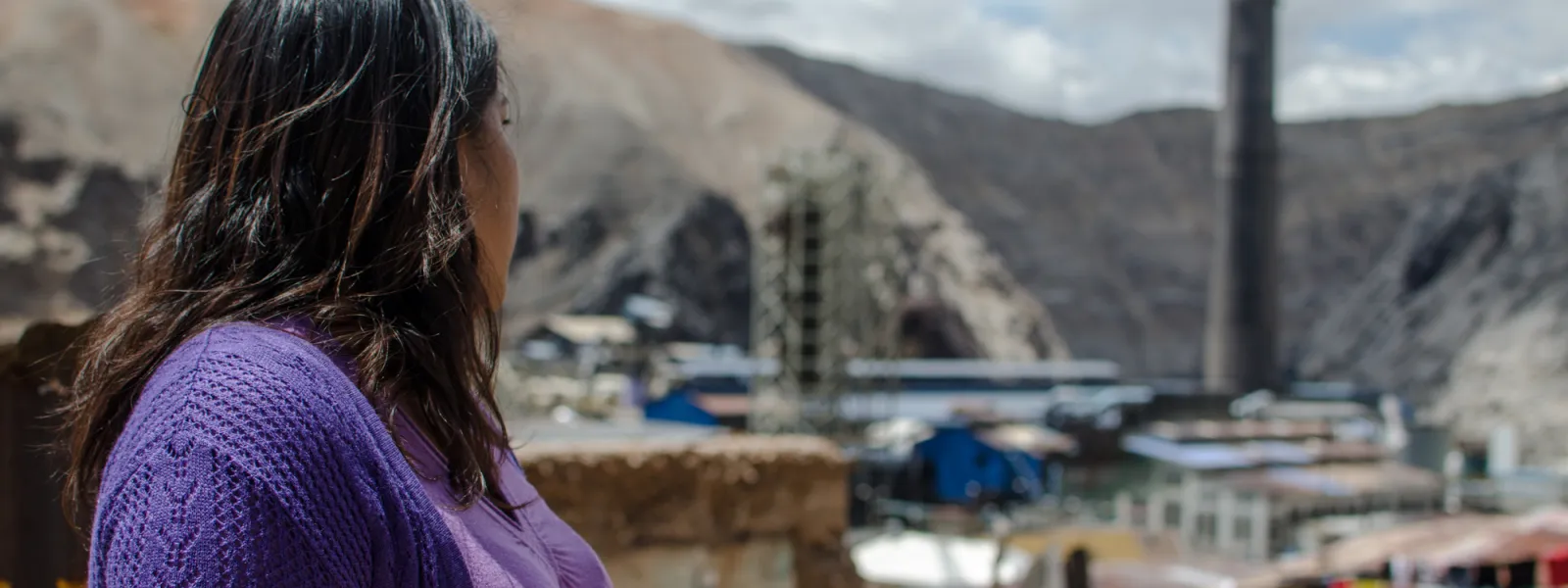
Project
Protecting the health of La Oroya's residents from toxic pollution
For more than 20 years, residents of La Oroya have been seeking justice and reparations after a metallurgical complex caused heavy metal pollution in their community—in violation of their fundamental rights—and the government failed to take adequate measures to protect them.
On March 22, 2024, the Inter-American Court of Human Rights issued its judgment in the case. It found Peru responsible and ordered it to adopt comprehensive reparation measures. This decision is a historic opportunity to restore the rights of the victims, as well as an important precedent for the protection of the right to a healthy environment in Latin America and for adequate state oversight of corporate activities.
Background
La Oroya is a small city in Peru’s central mountain range, in the department of Junín, about 176 km from Lima. It has a population of around 30,000 inhabitants.
There, in 1922, the U.S. company Cerro de Pasco Cooper Corporation installed the La Oroya Metallurgical Complex to process ore concentrates with high levels of lead, copper, zinc, silver and gold, as well as other contaminants such as sulfur, cadmium and arsenic.
The complex was nationalized in 1974 and operated by the State until 1997, when it was acquired by the US Doe Run Company through its subsidiary Doe Run Peru. In 2009, due to the company's financial crisis, the complex's operations were suspended.
Decades of damage to public health
The Peruvian State - due to the lack of adequate control systems, constant supervision, imposition of sanctions and adoption of immediate actions - has allowed the metallurgical complex to generate very high levels of contamination for decades that have seriously affected the health of residents of La Oroya for generations.
Those living in La Oroya have a higher risk or propensity to develop cancer due to historical exposure to heavy metals. While the health effects of toxic contamination are not immediately noticeable, they may be irreversible or become evident over the long term, affecting the population at various levels. Moreover, the impacts have been differentiated —and even more severe— among children, women and the elderly.
Most of the affected people presented lead levels higher than those recommended by the World Health Organization and, in some cases, higher levels of arsenic and cadmium; in addition to stress, anxiety, skin disorders, gastric problems, chronic headaches and respiratory or cardiac problems, among others.
The search for justice
Over time, several actions were brought at the national and international levels to obtain oversight of the metallurgical complex and its impacts, as well as to obtain redress for the violation of the rights of affected people.
AIDA became involved with La Oroya in 1997 and, since then, we’ve employed various strategies to protect public health, the environment and the rights of its inhabitants.
In 2002, our publication La Oroya Cannot Wait helped to make La Oroya's situation visible internationally and demand remedial measures.
That same year, a group of residents of La Oroya filed an enforcement action against the Ministry of Health and the General Directorate of Environmental Health to protect their rights and those of the rest of the population.
In 2006, they obtained a partially favorable decision from the Constitutional Court that ordered protective measures. However, after more than 14 years, no measures were taken to implement the ruling and the highest court did not take action to enforce it.
Given the lack of effective responses at the national level, AIDA —together with an international coalition of organizations— took the case to the Inter-American Commission on Human Rights (IACHR) and in November 2005 requested measures to protect the right to life, personal integrity and health of the people affected. In 2006, we filed a complaint with the IACHR against the Peruvian State for the violation of the human rights of La Oroya residents.
In 2007, in response to the petition, the IACHR granted protection measures to 65 people from La Oroya and in 2016 extended them to another 15.
Current Situation
To date, the protection measures granted by the IACHR are still in effect. Although the State has issued some decisions to somewhat control the company and the levels of contamination in the area, these have not been effective in protecting the rights of the population or in urgently implementing the necessary actions in La Oroya.
Although the levels of lead and other heavy metals in the blood have decreased since the suspension of operations at the complex, this does not imply that the effects of the contamination have disappeared because the metals remain in other parts of the body and their impacts can appear over the years. The State has not carried out a comprehensive diagnosis and follow-up of the people who were highly exposed to heavy metals at La Oroya. There is also a lack of an epidemiological and blood study on children to show the current state of contamination of the population and its comparison with the studies carried out between 1999 and 2005.
The case before the Inter-American Court
As for the international complaint, in October 2021 —15 years after the process began— the IACHR adopted a decision on the merits of the case and submitted it to the Inter-American Court of Human Rights, after establishing the international responsibility of the Peruvian State in the violation of human rights of residents of La Oroya.
The Court heard the case at a public hearing in October 2022. More than a year later, on March 22, 2024, the international court issued its judgment. In its ruling, the first of its kind, it held Peru responsible for violating the rights of the residents of La Oroya and ordered the government to adopt comprehensive reparation measures, including environmental remediation, reduction and mitigation of polluting emissions, air quality monitoring, free and specialized medical care, compensation, and a resettlement plan for the affected people.
Partners:
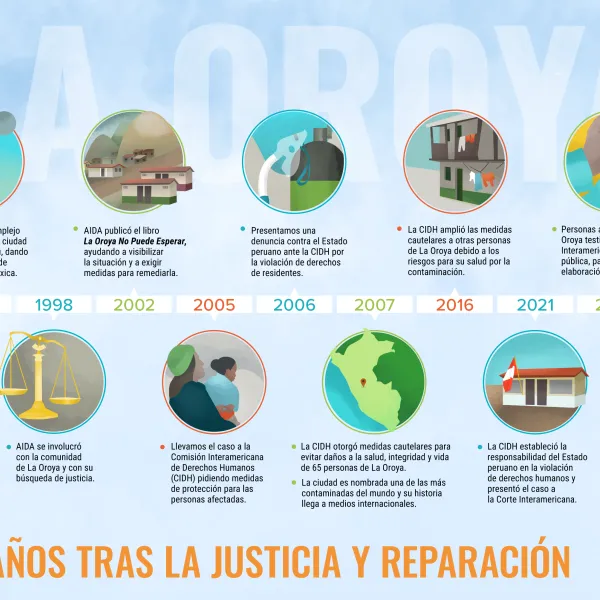
Related projects
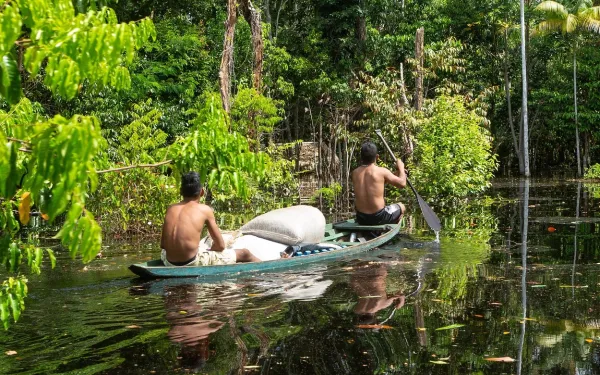
The triple planetary crisis: What is it and what can we do about it?
You may have heard that humanity is facing "a triple planetary crisis.” In the words of United Nations Secretary-General António Guterres, this crisis "threatens the well-being and survival of millions of people around the world." But what exactly does it mean? The triple planetary crisis refers to three interrelated problems: climate change, pollution, and biodiversity loss. Each of these problems is a crisis with its own causes and effects, but all three converge and feed on each other. All three affect human rights, and more intensely impact people in vulnerable conditions. The climate crisis The United Nations considers climate change to be humanity's most urgent problem and the greatest threat to human rights. Climate change, which involves long-term changes to the planet's temperatures and weather patterns, can completely alter ecosystems. Although changes in climate can occur due to the natural patterns of the planet, what we are facing is caused by human activities. Since the Industrial Revolution, there has been an accelerated change in the planet's average temperatures. One of the primary causes of that change is the exploitation and use of fossil fuels. The climate crisis, then, refers to the consequences of climate change caused by human activities, which include: an increase in the intensity and severity of natural events such as droughts, fires, and storms; rising sea levels and the melting of the poles; changes in the hydrological and climatic cycles that affect biodiversity; and impacts on the enjoyment of human rights. The pollution and waste crisis The dominant economic system, dependent on consumption, implies the generation of high levels of pollution and waste that have a great impact on human and ecosystem health. Air pollution is the leading cause of disease and premature death worldwide. The World Health Organization estimates that 7 million people die prematurely each year because of poor air quality. Air degradation is caused by emissions from factories, transportation, and forest fires. Those who lack access to less harmful technologies for cooking or keeping warm also breathe polluted air in their homes. Air pollution is related to climate change, as many of the emissions also warm the planet. Pollution caused by plastics and microplastics is another global concern, as it directly affects biodiversity. An increasing number of studies are finding that plastics are affecting the health of people and other living things. They take centuries to decompose, and are derived from petroleum, a fossil fuel. And we can’t forget pollution caused by extractive activities which, in addition to generating greenhouse gas emissions and leaving in their wake chemicals that are toxic to health, degrade freshwater sources and large tracts of land. The biodiversity loss crisis Biodiversity loss refers to the decrease and disappearance of biological diversity: flora, fauna, and ecosystems. This crisis is caused by the two previous crises, in addition to the overexploitation of resources and changes in land use—which cause overfishing, illegal hunting and trafficking, and deforestation—and the introduction of non-native and invasive species. This loss also implies the decline of many of the species on which we depend. Its impacts extend to affect food supplies and access to fresh water. One example is the Amazon, the world's largest tropical forest and a global climate stabilizer. It is home to 10 percent of the planet's known biodiversity and is the ancestral home of more than 470 indigenous and traditional peoples. The Amazon is endangered by colonization, deforestation, and extractive activities, among other threats. The situation is so serious that the point of no return for the Amazon, in which deforestation levels cancel out its capacity for regeneration, is no longer a future scenario. Actions to confront the triple planetary crisis The triple planetary crisis is a complex problem involving diverse stakeholders and requiring multidisciplinary solutions. Although local actions and individual lifestyle changes can help, many of the necessary actions require decisions on a global scale and profound changes to economic, political, and social systems. According to the United Nations, global actions to confront the crises must include: Limiting global temperature increase to 1.5 degrees: this means that global emissions should be reduced by 45 percent by 2030, with the goal of achieving carbon neutrality by 2050. Accelerating the expansion of clean renewable energies: to achieve the above, a drastic reduction in the use of fossil fuels is required to make way for energy systems based on renewable sources that are sustainable over time and respectful of the environment and people. In addition to combating climate change, this would reduce air pollution. Investing in adaptation and resilience: this means considering those who are already suffering the impacts of the climate crisis in the solutions, with emphasis on the nations, people, and communities in vulnerable situations and who are least responsible for these crises. Conserving and protecting 30 percent of the planet: this applies particularly to areas of biodiversity importance, including the ocean. It also implies actions to mitigate climate change. Improving the food system: this includes changes in irrigation and soil management, as well as producing healthier food and reducing food waste. Leaving no one behind: the measures described above must be carried out simultaneously and with a focus on protecting human rights, as they represent an opportunity to reduce the inequalities that are both a cause and a consequence of the crises. Making progress before the triple crisis These crises threaten not only our basic sources of livelihood, but even our mental health. And while much remains to be done, progress has been made that demonstrates the global cooperation needed to advance on a large scale. We’re happy to share some recent examples of global progress: The High Seas Treaty, designed to protect two-thirds of the ocean, was adopted in June 2023, and will need to be ratified by 60 countries before entering into force. The United Nations recognized the right to a clean, healthy, and sustainable environment as a universal right. 175 nations agreed to develop a global instrument to address plastic pollution. The steps we take as individuals help us to act locally: to live our values and contribute to our communities. But it’s also important we think globally, and demand that our representatives in decision-making bodies guarantee widespread participation and commit to taking key and concerted actions.
Read more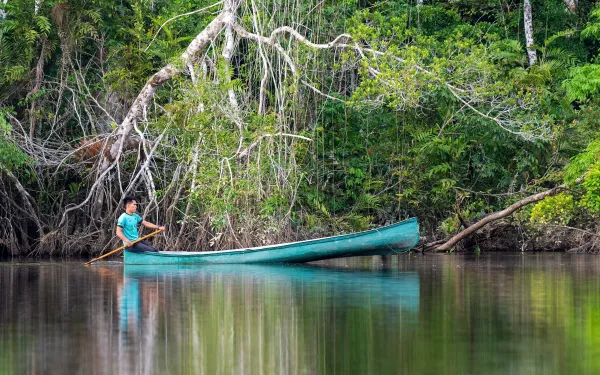
10 positive advances for the environment in Latin America in 2023
It has been a tumultuous year for the world in many ways, and the climate crisis remains one of the greatest challenges we face as a human race. However, it is always worthwhile to assess and recognize the progress made in the quest for environmental and climate justice. So, as we close 2023, let’s celebrate the agreements, decisions, and milestones that give us hope as we continue to defend the planet and all the creatures that call it home. 1. The world has a treaty to preserve life on the high seas. After two long weeks of final negotiations, and decades of previous work, United Nations member states have agreed on a High Seas Treaty to protect two-thirds of the ocean, representing nearly half of the surface of the planet. The new treaty will provide a blueprint for establishing protected areas on the high seas and for assessing and managing human activities that could affect life in this vast area. It will also help achieve the global goal of protecting 30 percent of the ocean by 2030. It has been signed by nearly 80 countries and is in the process of ratification to enter into force. 2. The Ecuadorian people decide to protect the Amazon. Ecuador held a popular consultation to decide whether to stop oil exploration in part of the Yasuní National Park, one of the most biodiverse areas on the planet. The great news is that about 60 percent of the population chose to protect this region of the Amazon, leaving some of the oil in the ground. By recognizing the value of a key ecosystem for stabilizing the global climate, this result transcends national boundaries. It is a hopeful sign of climate ambition that can drive the necessary just energy transition worldwide. 3. The UN recognizes activism for the right to a healthy environment. The United Nations has awarded the 2023 Human Rights Prize to the Global Coalition of Civil Society, Indigenous Peoples, Social Movements and Local Communities for the Universal Recognition of the Human Right to a Clean, Healthy and Sustainable Environment. The prize is awarded every five years, and this is the first time since its inception that it has been given to a global coalition. It recognizes the coalition's essential role in the recognition of the right to a healthy environment by the UN General Assembly in 2022, as well as decades of civil society efforts and spaces for public participation. 4. Support grows for moratorium on deep-sea mining. There is currently a call for the International Seabed Authority to pause negotiations on the regulation of undersea mineral exploitation while the necessary information is gathered to understand the impact of this extractive activity on the ocean, species, and people. Mexico was the most recent signatory in November, joining other countries of the region— including Brazil, Chile, Costa Rica, Ecuador, Panama, and the Dominican Republic— in calling for a moratorium on deep-sea mining. You can join their efforts and learn more by following the hashtag #DefendTheDeep. 5. A Fossil Fuel Non-Proliferation Treaty is in the making. Colombia, a major coal producer, was the first Latin American country to join the call for a Fossil Fuel Non-Proliferation Treaty, a global initiative to complement the Paris Agreement. Cities, elected officials, and international organizations such as the World Health Organization have joined the call. The goal of the proposal, led by Pacific Island countries, is to create a follow-up plan to halt the expansion of fossil fuel use and initiate a just transition. For more information, visit the Fossil Fuels Treaty website. 6. There are signs of hope for a "sacrifice zone" in Chile. Although much remains to be done, recent events give hope that things may be looking up in Quintero and Puchuncaví bays, whose residents have suffered decades of pollution from a series of companies. In May, after 58 years of operation, the furnaces and boilers of the Ventanas smelter were finally shut down. Similarly, the multinational company that owns the Ventanas II thermoelectric plant, also located in the bay, announced its definitive closure by the end of this year. Furthermore, the Supreme Court has issued three rulings related to the failure to comply with a 2019 judgment—which orders the state to adopt 15 measures to identify the sources of contamination and repair the environmental situation in the area—and provides tools for its enforcement. Read more about the case in Chao Carbón. 7. Court rules the Colombia must take concrete climate action. Within one year, Colombia's Ministry of Environment and Sustainable Development must adopt concrete measures to adapt to and mitigate the climate crisis. This order was issued by the Council of State, a high court, as the result of a lawsuit alleging that the ministry had failed to comply with the climate commitments contained in national legislation. Colombia, as the largest exporter of thermal coal in Latin America, has an obligation to include in its climate commitments the real dimension of the impacts of extracting, transporting, and burning coal. This case could become a precedent for strategic and successful climate litigation at the regional and international levels. 8. Cajamarca, Colombia continues to set an example for environmental democracy. Popular consultations will be respected. A Colombian court made this clear by upholding the legality of the popular consultation in which the people of Cajamarca rejected AngloGold Ashanti's La Colosa gold mega-mining project. The ruling represents a triumph for participatory democracy and the defense of peasant territories against extractivism. It sets an important precedent for respecting other popular consultations throughout the country and serves as an example for the rest of the region. 9. A regional alliance to protect Andean wetlands is born. The Alliance for Andean Wetlands is a coalition of social and environmental organizations that aims to promote the protection and conservation of Andean wetlands, water, biodiversity, territories, and the lives of indigenous and campesino communities in Latin America, particularly in Argentina, Bolivia, and Chile. Andean wetlands— including salt flats, lakes, and lagoons —are globally recognized as ecosystems of high ecological and social importance. However, they are also very fragile and threatened by the climate crisis and by extractive activities such as the mining of lithium, copper, and other minerals considered "critical" for the transition to new forms of energy production. 10. AIDA celebrates 25 years of working for a healthy environment. This year we celebrate our 25th anniversary, a quarter century of defending the right to a healthy environment in Latin America. Our journey and our impact have been made possible by a great community of allies with whom we have worked and with whom we share this year of celebration. This milestone enabled us to reflect on our accomplishments, which are reflected in our 2023 Annual Report, and to define a vision for the coming years focused on the quest for climate and environmental justice in the region. Thank you for being part of these 25 years and the decades to come!
Read more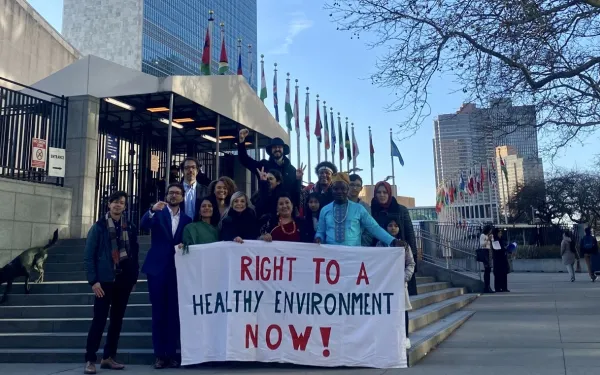
Right to a Healthy Environment Global Coalition awarded UN Human Rights Prize
New York — Today the Global Coalition of Civil Society, Indigenous Peoples, Social Movements, and Local Communities for the Universal Recognition of the Right to a Clean, Healthy, and Sustainable Environment accepted the prestigious 2023 United Nations Human Rights Prize in a ceremony in New York. This month also marks the 75th anniversary of the Universal Declaration of Human Rights.The coalition is recognized for its vital role in advocating for the universal recognition of the right to a healthy environment by the UN General Assembly (UNGA) in 2022. The UN Human Rights Prize is awarded once every five years to several recipients at a time. This year is the first time since its inception in 1966 that it has been granted to a global coalition.The prize was presented at a ceremony with UN leadership, including General Assembly President Dennis Francis, Secretary-General António Guterres, and High Commissioner for Human Rights Volker Türk. The award was accepted by a delegation of representatives illustrating the diversity of the coalition’s members.The ceremony took place alongside a workshop with advocates from around the world and UN and State representatives to assess progress since the recognition of the right to a healthy environment and to discuss next steps to build on that progress and ensure the effective promotion of the right.Read reactions to the announcement from the members of the coalition here.At the ceremony, the following acceptance speech was delivered by a representative of the coalition: We, Civil Society, Indigenous Peoples, Social Movements, and Local Communities in coalition for the Universal Recognition of the Human Right to a Clean, Healthy, and Sustainable Environment are honored to receive this prestigious prize acknowledging our vital role towards the UN recognition of this human right.This incredible achievement was only possible thanks to the tireless collaborative efforts of thousands of people from 143 countries who joined for this historic milestone. A process that started fifty years ago by visionaries gained momentum in 2020 when we called the UN to finally recognize this human right.First, this prize highlights the importance of truly collaborating to advance the imperative protections of our planet and our rights. No single organization, movement, or person would have been able to make it on their own, but together, our global and diverse coalition made it possible. We are humbled and proud that our efforts are recognized, evidencing to the world that working together is possible and worth it.Cooperation is just as needed for States, none of whom can, on their own, solve today’s multiple planetary crises of biodiversity loss, climate change, and pollution, aggravated by increasing inequalities. We call on States to effectively collaborate towards the solutions needed.Second, this prize reinforces the historic recognition of the right to a clean, healthy, and sustainable environment as a human right. That requires protecting the dignity of all persons, individually and collectively, substantively and procedurally, from human-made environmental degradation and climate change impacts. Affirming also the interdependence and indivisibility of human rights and the urgency to protect them from environmental threats, including systemic risks, irreversible degradation, and loss and damage.The UN recognition clarifies international human rights law and is now a powerful instrument for States to fulfill their obligations, enhance environmental justice, and guarantee all rights, especially of those in more vulnerable situations.As we witness increasing ecosystem degradation and lives lost due to pollution and climate change, this universal right can guide us toward stronger policies and practices, based on gender and intergenerational equity and the empowerment of all persons and communities. It can help in better protecting those defending the environment, including Indigenous Peoples, children, women, peasants, and other people working in rural areas.We are profoundly grateful for the recognition of our collective efforts, inspiring governments, businesses, and institutions to fulfill their responsibility and effectively protect our universal right to a clean, healthy, and sustainable environment. This is our priority, one we invite you to commit to. Thank you! Press contactsVíctor Quintanilla (Mexico), Content Coordinator at the Interamerican Association for Environmental Defense (AIDA), [email protected] Furbank, Communications Campaign Specialist at the Center for International Environmental Law, [email protected] Esther de la Rosa, Communications Coordinator at ESCR-Net [email protected]
Read more